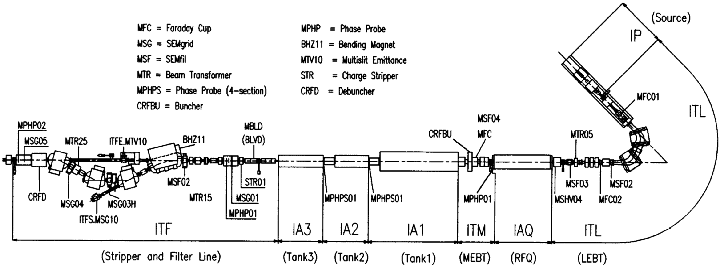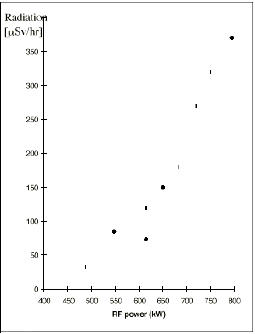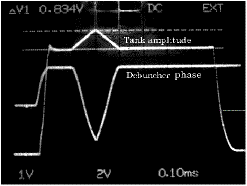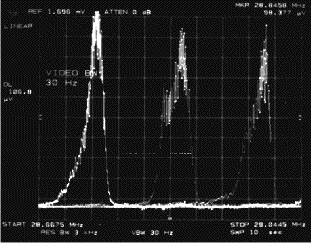For the CERN Lead Ion Accelerating Facility (achieved within a collaboration of several outside laboratories and with financial help of some member states) a new dedicated Linac has been built. This Linac has been installed in 1994 and served during two extended physics runs.
This paper reviews the main characteristics of this
machine and describes the first operational experience. Emphasis
is put on new features of this accelerator, its associated equipment
and on the peculiarities of heavy ions.
The Pb injector Linac is part of the Lead Ion Accelerating Facility at CERN 1 which has been described at different conferences 2,3. This project has not been a CERN project but a joint project with several outside laboratories and helped also by outside financial contributions.
The work reported here is the result of a collaboration between different laboratories, namely GANIL (Caen, France), Legnaro (INFN, Italy), GSI (Darmstadt, Germany), Torino (University, Italy) and CERN (Geneva, Switzerland), supported by financial contributions from Sweden and Switzerland. and helped with software and some hardware from India (VECC, Calcutta, TIFR and BARC, Bombay), a debuncher from IAP (Frankfurt, Germany) and manpower for installation from Prague (Czech Academy of Sciences).
The Pb injector Linac ("Linac 3") started
operation in June 1994 and first results have been presented at
the last Linac Conference 4, where also some papers on details
of the machine were submitted 5,6,7,8.
The design of this machine was decided to a large
extent by the characteristics of the existing CERN machines and
their auxiliary equipment and of course also by our collaborators,
their experience and possibilities. Fig. 1 shows the layout
of the whole facility. Several considerations determined the choice
of the machine parameters. From the future experiments there was
the request for a certain minimum intensity to be made available
(5107 ions per SPS supercycle) and the other important
boundary was the cost factor. CERN had no major funds available
for up-grading its machines to heavy ions and the future ion experiments
were struggling with their own financial problems but several
of the institutes involved were willing to contribute in kind.
The choice for the machine parameters had to be made by taking
into account these conditions.

It was evident that a new Linac would be needed and
to minimise its cost a source with a high charge state had to
be selected. Given the good performance of ECR (electron cyclotron
resonance) sources, the positive experience in using them at CERN
and their availability from a collaborating lab (GANIL), the choice
for the future linac was quite clear. A filter line to select
the desired charge state and a RFQ for further acceleration were
obvious choices (experience at INFN Legnaro). The linac itself
has been an open question for some time and was finally determined
by the positive results at GSI with their high charge state injector
using an interdigital H structure ("IH"). Its compact
design and - for its length - modest RF power requirements and
the possibility to profit from GSI's and its subcontractors experience
made it an attractive choice for Linac 3. An important parameter
was of course the final energy of the linac. It has been determined
by careful consideration of:

The final choice made here was 4.2 MeV/u at
the output of the Linac and stripping at this energy to Pb53+.
The ion source
The first element of the Linac is the ECR source
delivering in a pulsed mode (the so called "afterglow")
a current of 120 A of 208Pb27+. The
source is operating at 10 Hz, the frequency chosen for future
operation for the LHC (CERN's Large Hadron Collider) and compatible
with all the new machine components. It maybe recalled that the
original specification for this source was 30 A and during
its construction phase the afterglow mode was applied pushing
its performance to above 80 A. Careful tuning and some modifications
resulted in the present intensity.
The Low Energy Beam Transport
To transport the beam from the ion source into the
RFQ, a special line has been designed, which does not only match
the beam into the RFQ. It acts also as a high resolution spectrometer
(0.3 %), that eliminates the unwanted charge states and even
the unwanted isotopes, if needed.
The RFQ and the Medium Energy Beam Transport
The RFQ is of the four rod type and has symmetric
supports for the vanes. It accelerates the beam from 2.5 keV/u
to 250 keV/u with a very good transmission. With one buncher
cavity and two quadrupole doublets matching is achieved into the
first IH tank.
The IH Linac
Three cavities accelerate the beam to 1.8, 3.1 and
4.2 MeV/u respectively. The first tank operates like the
RFQ at 101.3 MHz, tanks 2 and 3 at 202.56 MHz. Transverse
focusing is provided by quadrupole triplets, two in tank 1, one
between tanks 1 and 2, and one between tanks 2 and 3.
Stripper and Filter Line
Another magnetic quadrupole triplet is employed after
tank3 to focus the beam onto the carbon stripper foil to minimise
the transverse emittance blow-up. An arrangement of four bending
magnets is used with a slit in the middle to analyse the beam
and to select the required charge state (normally Pb53+).
The first bending magnet is stronger, such as to allow spectrometer
measurements even for the (un-stripped) Pb27+ beam.
Instrumentation
Instrumentation on Linac 3 is vital, not only because
several different labs were involved in the construction, which
meant that beam quality checks were important at the hand-over
points, but also due to the additional complications when working
with heavy ions. Beam current measurements are achieved by transformers
and faraday cups. Profile measurements are done with secondary
emission grids and the longitudinal beam characteristics are monitored
with capacitive phase probes (some with four sectors to allow
for position measurements) and a so called BLVD (Bunch Length
and Velocity Detector) [9]. Apart from the existing emittance
measuring lines a special multislit/scintillator screen device
has also been set up [10].
Installation
Installation of the source had been achieved already
at the end of 1992. In July 1993 the LEBT was used to measure
the source characteristics. By then most of the filter line had
been installed too. Tanks 2 and 3 arrived in December 1993, tank
1 in February 1994 and the RFQ in April 1994.
The somewhat hectic installation period in 1994 was followed by a very fast running in. This was necessary because it was clear that the subsequent machines, not used to
partially stripped heavy ions, would require a fairly extended period for setting-up.
Conditioning of the RF cavities caused no major problems. Some days were in general sufficient to overcome problems. The buncher behind the RFQ, however, suffered from operating ion pumps and even from the very low intensity beam passing through the RFQ when it was not yet powered. This beam coming from the source before the maximum of the after glow pulse was finally suppressed to have reliable operation of the buncher. In spite of the fast running in careful measurements were done using the sophisticated equipment available for beam diagnosis. Provisional installation to measure the beam out of the RFQ and out of tank 1 were made to check the performance of the subsystems before injecting into the next unit. The BLVD in particular proved its value.
No major problems were encountered. Vacuum conditions
throughout the linac were completely adequate. Some weak points
on some RF amplifiers (failing HT components and insufficient
cooling) have been corrected.
Work continued on different improvements concerning
the ion source, triplet and tank alignment and also the field
distribution in the tanks. Some problems with the mechanics of
the stripper were also tackled. Table 1 shows the original, the
design and the present performance of Linac 3.
| Source current A | Linac output current
A | Horizontal emittance (norm.)
mm mrad | Vertical emittance (norm.)
mm mrad | energy spread keV/u | |
| design | 80 | 65 | .81 | .80 | 2.1 |
| 1994 | 80 | 60 | 1.2 | 1.1 | 2.5 |
| present | 120 | 90 | .85 | .80 | 2.2 |
Table 1: Linac beam characteristics (Emittances are
4 the rms values, the energy spread is given after debunching)
Although it is true that the original specifications for the minimum intensity have been exceeded by a factor of eight, future physics experiments will probably require higher intensities (e.g. the search for strangelets). In any case the LHC (Large Hadron Collider) where lead ions will be accelerated to a few TeV/u will require higher intensities to achieve a reasonable luminosity.
Apart from intensity improvements on the source, which will reflect proportionally on the final intensities, and improvements in the transmission of the circular accelerators, several scenarios have been studied for the LHC [12]. Present planning calls for a faster (10 Hz) repetition rate of the linac and injection into LEAR (Low Energy Antiproton Ring). Accumulation of about ten pulses and electron cooling would provide for the intensities and emittances needed for the LHC 13.
First electron cooling tests were performed in LEAR with Pb53+ ions in December 1994. Considerably better lifetimes of the beam were achieved using Pb54+ ions [13]. The current after the stripper at the Linac exit for Pb54+ can be made equal to the normal Pb53+ current by optimising the stripper foil.
Another possibility, depending on ion source development
[14], is a high current, short pulse, source (EBIS or Laser source)
that could provide the necessary intensity and keep the required
low emittance by mono turn injection into the PSB. Work in this
field is going on in some labs, e.g. BNL (EBIS) and CERN (laser
source, in collaboration with ITEP and TRINITI, [15] ).
Tests with Higher RF Power
Some interesting experiments were performed in collaboration
with GSI. The IH structure shows very good voltage holding capabilities
in spite of the small radius of curvature on the drift tubes.
Tests were made on tank 2 with considerably higher RF powers than
nominal. The normal operating level requires 346 kW. Test
made in 1995 with 550 kW showed excellent behaviour. In 1996
an increased power level of 800 kW was successfully applied.
The conditioning of the tank took about 18 hours with a repetition
rate of slightly below 1 Hz and 200 s pulse length. The radiation
values during conditioning are presented in Fig. 3. The radiation
is measured 90 cm from the tank axis.

The two points around 620 kW are taken at different times. Basically this figure shows the radiation increase as RF conditioning proceeds. These values are not to be taken as the values under normal operation.
The design and actually achieved fields in tank 2
are shown in table 2. It must be stressed that these values have
been realised with a very short conditioning time and are certainly
not yet the maximum levels that can be obtained. These levels
were determined by the maximum RF power available with the present
configuration.
| Design Fields
[MV/m] | Scaled to 800 kW [MV/m] | |
| Effective accelerating field | 6.4 | 9.3 |
| Average field in gaps with highest gradient | 15.8 | 24.0 |
Table 2: Accelerating fields in tank 2 for the design
conditions and scaled to 800 kW
We plan to have RF power available for further tests
with up to 2 MW to reach (perhaps) the breakdown limit of
the tank.
"Energy Ramping" During the Pulse
Multiturn injection into LEAR, to accumulate, cool and store ions for the LHC, maybe helped by an energy variation during the beam pulse. Requirements for this scheme are: a relative momentum variation of 0.4 % during a Linac pulse of 20 to 60 s whilst keeping the beam momentum dispersion within 0.02 % at 1 . Several machine experiments ("MDs") were made to test the feasibility of this scheme.
Dynamic ramping with the debuncher phase alone did not give the required results. Additional ramping with the tank 3 amplitude (Fig. 4) yielded the necessary variations for the energy together with the required energy dispersion. Fig. 5 shows the energy dispersion in the beginning, the middle and the end of the ramp (superimposed pictures). The variation is ± 40 keV/u and the dispersion is about 10 keV/u.
Ramping with parameters of a machine, which is built to supply constant energy, means of course deviating from the optimum settings and results in a reduced stability and a more delicate operation. The best solution appears to be a dedicated energy corrector cavity:
Another important application of special and dedicated
hardware for the energy ramping for LEAR is to keep the injection
energy into the Booster constant in spite of changes of or on
the stripper foil. Stripper foils usually show some variations
in thickness and replacing one foil produces inherently a change
in the energy of the stripped beam.


These changes are quite difficult to cope with on
the Booster machine which requires a lengthy resetting of the
injection and especially of the RF parameters. As the necessary
stripper foil changes cannot always be predicted and preventive
maintenance is hence excluded it is usually tried to trim the
Linac energy to another value to compensate for the different
stripper foil. It is clear, however, that this means - as a Linac
is a fixed energy machine - deviating from the optimum settings.
For this reason it is highly desirable to have a special energy
corrector cavity after the Linac which allows energy corrections
without touching the optimised parameters of the Linac itself.
Another problem that could be eased by a dedicated cavity, is
ageing of the stripper foil, which can result both in energy variations
and in changes of the energy dispersion.
Tests with Pb25+
Although 208Pb25+ had been
foreseen as "nominal ion" right from the beginning,
all the initial running including the physics runs of 1994 and
1995 had been done with Pb27+. The high intensity the
source was able to provide, and the lower RF power needed for
the Linac cavities, made this a good choice. However if the source
can give the same (electric) current of Pb25+ there
is already a gain of some 8% in terms of number of ions. It must
be remembered in this context, that the Linac accelerates to 4.2 MeV/u
(by adjusting the field levels correspondingly) independent of
the charge state of the ion. The output of the stripper in terms
of Pb53+ is again independent of the charge state of
the incoming ion and depends solely on its energy. Hence converting
the same current of Pb25+ will result in 8% higher
current after the stripper. Preliminary tests are under way to
explore this possibility and have quickly produced an increase
of the current by some 11%. The overall gain in terms of number
of ions is hence about 20%. There is some hope that this mode
of operation can be used for the physics run later this year and
that further optimisation of the source can give even higher intensities.
Stripper foil ageing
The carbon stripper foils show a very good lifetime
of several months. Some ageing effects have been observed that
are of importance for the Booster synchrotron. Fig. 6 shows the
energy spectrum (after the debuncher) with a stripper foil of
a few months (note the Pb54+ on the right), fig.7 shows
the same spectrum under identical machine conditions but with
a new foil.


With the old foil one can clearly see a low energy
tail in the spectrum. Some curling of the foil maybe the reason.
This effect reduces considerably the trapping efficiency of the
Booster. Fortunately it is easy, if the effect is noticed, to
put in a new foil.
The CERN Linac 3 put into operation in 1994 has been working very well and exceeding most of the specifications, in particular the ones relevant for the subsequent machines. It has been demonstrated that such a machine can be built by a large collaboration of several labs from different countries without making compromises for the final performance.
It is a pleasure to acknowledge here the enormous help given to this project by our friends from the collaborating institutions, in particular from GANIL, Legnaro, GSI and Torino, but also from IAP, CAT and Prague and of course also - last but not least - the financial contribution by Sweden and Switzerland. Thanks are of course also due to the CERN people in the different groups of the PS division, and likewise from the previous AT, MT, ST and TIS divisions.
Special thanks go to several of my colleagues in
the PS for supplying material for this paper especially to C. E. Hill,
A. Lombardi, E. Tanke and R. Scrivens.
[1] N. Angert, M. P. Bourgarel, E. Brouzet, R. Cappi, D. Dekkers, J. Evans, G. Gelato, H. Haseroth, C. E. Hill, G. Hutter, J. Knott, H. Kugler, A. Lombardi, H. Lustig, E. Malwitz, F. Nitsch, G. Parisi, A. Pisent, U. Raich, U. Ratzinger, L. Riccati, A. Schempp, K. Schindl, H. Schönauer, P. Têtu, H. H. Umstätter, M. van Rooij, D. Warner (editor), M. Weiss, CERN Heavy Ion Facility Design Report, CERN 93-01.
[2] H. Haseroth, "The CERN Heavy Ion Facility", Proc. of the Fourth European Particle Acc. Conf., EPAC94, London.
[3] H. Haseroth, "The CERN Heavy Ion Accelerating Facility", Proc. of the 1995 Particle Accelerator Conf., Dallas, 1995
[4] D. J. Warner, for the Linac 3 Running In Team, "The Heavy Ion Linac for the CERN Lead Ion Facility", Proc. of the 1994 International Linac Conf., Tsukuba.
[5] A. Lombardi, A. Pisent, M. Weiss, K. Langbein, Alessandra Lombardi, E Tanke, H.Umstätter, " Measured Performances of the LEBT of the Heavy Ion Linac of the CERN Lead Ion Facility", Proc. of the 1994 International Linac Conf., Tsukuba.
[6] A. Bezzon, A. Lombardi, A. Pisent, M. Weiss, P. Bourquin, Alessandra Lombardi, G. Parisi, M. Vretenar, "Construction and Commissioning Experience with the RFQ of the Heavy Ion Linac of the CERN Lead Ion Facility", Proc. of the 1994 International Linac Conf., Tsukuba.
[7] A. Facco, A. Lombardi, A. Pisent, M. Weiss, Alessandra Lombardi, W. Pirkl, M. Vretenar, "The Matching Line between the RFQ and the IH of the Heavy Ion Linac of the CERN Lead Ion Facility", Proc. of the 1994 International Linac Conf., Tsukuba.
[8] N. Angert, W. Bleuel, H. Gaiser, G. Hutter, E. Malwitz, R. Popescu, M. Rau, U. Ratzinger, Y. Bylinski, H. Haseroth, H. Kugler, R. Scrivens, E. Tanke, D. Warner, "The IH Linac of the CERN Lead Injector", Proc. of the 1994 International Linac Conf., Tsukuba.
[9] YU.V. Bylinsky, A.V. Feschenko, A.V. Liiou, Men'shov, P.N. Ostroumov, H. Kugler, D.J. Williams, "Bunch Length and Velocity Detector and its Application in the CERN Heavy Ion Linac", EPAC94.
[10] M. Crescenti, U. Raich, "A Single Pulse Beam Emittance Measurement for the CERN Heavy Ion Linac", Proc. of the Second European Workshop on Beam Diagnostics and Instrumentation for Particle Accelerators, DESY 1995.
[12] D. Brandt, E. Brouzet, R. Cappi, J. Gareyte, R. Garoby, H. Haseroth, P. Lefèvre, S. Maury, D. Möhl, F. Pedersen, K. Schindl, T.R. Sherwood, L. Thorndal, D. Warner, "High Intensity Options for the CERN Heavy Ion Programme", Proc. of the 2nd European Particle Acc. Conf., Nice 1990, vol. 1, p.49.
13 J. Bosser, J. Broere, C. Carli, M. Chanel, C. Hill, R. Ley, A. Lombardi,R. Maccaferri, S. Maury, G. Molinari, D. Möhl, H. Mulder, E. Tanke, G.Tranquille, "Lear Machine Studies to Test Ion Accumulation for the LHC. Summary March-April 1996", CERN, PS/AR/Note 96-09 (MD), 18 June 1996
[14] H. Haseroth, C. E. Hill, "Multicharged Ion Sources for Pulsed Accelerators"' Rev. Sci. Instrum. 67 (3), March 1996, p. 945
[15] H. Haseroth, H. Kugler, K. Langbein, A. Lombardi, W. Pirkl, R. Scrivens, T. Sherwood, A. Ster, A. Tambini, E. Tanke, S.A. Kondrashev, V. Roudskoy, B. Yu. Sharkov, A. Shumshurov, L. Laska, K., Rohlena, J. Wolowski, E. Woryna, K.N. Makarov, V.C. Roerich, Yu. A. Satov, A. E. Stepanov, "Laser Ion Source Development for Heavy Ions", this conference.